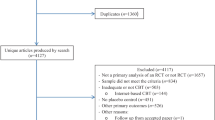Abstract
The management of chronic pelvic pain (CPP) in women requires a multimodal approach, as such pain is often generated both centrally and peripherally. The role of neurobiological and neuropsychological factors in contributing to CPP should be considered. The comprehensive management of CPP in women includes the use of pharmacological options (e.g. analgesics, hormonal suppression, anaesthetics, antidepressants, membrane stabilizers and anxiolytics) and non-pharmacological interventions (pelvic floor physical therapy, cognitive behavioural therapy, lifestyle modifications).
Similar content being viewed by others
References
Howard FM. ACOG practice bulletin no. 51: chronic pelvic pain. Obstet Gynecol. 2004;103:589–605.
Carey ET, Till SR, As-Sanie S. Pharmacological management of chronic pelvic pain in women. Drugs. 2017;77(3):285–301.
Marjoribanks J, Ayeleke RO, Farquhar C, et al. Nonsteroidal anti-inflammatory drugs for dysmenorrhoea. Cochrane Database Syst Rev. 2015;2:CD001751.
Garcia-Rodriguez LA. Nonsteroidal antiinflammatory drugs, ulcers and risk: a collaborative meta-analysis. Semin Arthr Rheum. 1997;26:16–20.
Makin AJ, Williams R. Acetaminophen-induced hepatotoxicity: predisposing factors and treatments. Adv Intern Med. 1997;42:453–83.
Centers for Disease Control and Prevention. Public Health Service, U.S. Department of Health and Human Services. Guideline for prescribing opioids for chronic pain. J Pain Palliat Care Pharmacother. 2016;30(2):138–40.
Falcone T, Lebovic DI. Clinical management of endometriosis. Obstet Gynecol. 2011;118:691–705.
Brown J, Pan A, Hart RJ. Gonadotrophin-releasing hormone analogues for pain associated with endometriosis. Cochrane Database Syst Rev. 2010;12:CD008475.
Telimaa S, Puolakka J, Kauppila A. Placebo-controlled comparison of danazol and high-dose medroxyprogesterone acetate in the treatment of endometriosis. Gynecol Endocrinol. 1987;1:13–23.
Foster DC, Kotok MB, Huang L-S, et al. Oral desipramine and topical lidocaine for vulvodynia: a randomized controlled trial. Obstet Gynecol. 2010;116:583–93.
Labat JJ, Riant T, Lassaux A, et al. Adding corticosteroids to the pudendal nerve block for pudendal neuralgia: a randomised, double-blind, controlled trial. BJOG. 2016;124:251–60.
Scott NA, Guo B, Barton PM, et al. Trigger point injections for chronic non-malignant musculoskeletal pain: a systematic review. Pain Med. 2009;10:54–69.
Sator-Katzenschlager SM, Scharbert G, Kress HG, et al. Chronic pelvic pain treated with gabapentin and amitriptyline: a randomized controlled pilot study. Wien Klin Wochenschr. 2005;117:761–8.
Moldofsky H, Harris HW, Archambault WT, et al. Effects of bedtime very low dose cyclobenzaprine on symptoms and sleep physiology in patients with fibromyalgia syndrome: a double-blind randomized placebo-controlled study. J Rheumatol. 2011;38:2653–63.
Gendreau RM, Thorn MD, Gendreau JF, et al. Efficacy of milnacipran in patients with fibromyalgia. J Rheumatol. 2005;32:1975–85.
Lewis SC, Bhattacharya S, Wu O, et al. Gabapentin for the management of chronic pelvic pain in women (GaPP1): a pilot randomised controlled trial. PLoS One. 2016;11:e0153037.
Muehlbacher M, Nickel MK, Kettler C, et al. Topiramate in treatment of patients with chronic low back pain: a randomized, double-blind, placebo-controlled study. Clin J Pain. 2006;22:526–31.
Carrico DJ, Peters KM. Vaginal diazepam use with urogenital pain/pelvic floor dysfunction: serum diazepam levels and efficacy data. Urol Nurs. 2011;31:279–84.
Ferrero S, Gillott DJ, Venturini PL, et al. Use of aromatase inhibitors to treat endometriosis-related pain symptoms: a systematic review. Reprod Biol Endocrinol. 2011;9:89.
Soysal S, Soysal ME, Ozer S, et al. The effects of post-surgical administration of goserelin plus anastrozole compared to goserelin alone in patients with severe endometriosis: a prospective randomized trial. Hum Reprod. 2004;19:160–7.
Diamond MP, Carr B, Dmowski WP, et al. Elagolix treatment for endometriosis-associated pain: results from a phase 2, randomized, double-blind, placebo-controlled study. Reprod Sci. 2014;21:363–71.
Turini D, Beneforti P, Spinelli M, et al. Heat/burning sensation induced by topical application of capsaicin on perineal cutaneous area: new approach in diagnosis and treatment of chronic prostatitis/chronic pelvic pain syndrome? Urology. 2006;67:910–3.
Rocha MG, e Silva JC, da Silva AR, et al. TRPV1 expression on peritoneal endometriosis foci is associated with chronic pelvic pain. Reprod Sci. 2011;18:511–5.
Abbott JA, Jarvis SK, Lyons SD, et al. Botulinum toxin type A for chronic pain and pelvic floor spasm in women: a randomized controlled trial. Obstet Gynecol. 2006;108(4):915–23.
Jarvis SK, Abbott JA, Lenart MB, et al. Pilot study of botulinum toxin type A in the treatment of chronic pelvic pain associated with spasm of the levator ani muscles. Aust N Z J Obstet Gynaecol. 2004;44(1):46–50.
Younger J, Parkitny L, McLain D. The use of low-dose naltrexone as a novel anti-inflammatory treatment for chronic pain. Clin Rheumatol. 2014;33:451–9.
Younger J, Noor N, McCue R, et al. Low-dose naltrexone for the treatment of fibromyalgia: findings of a small, randomized, double-blind, placebo-controlled, counterbalanced, crossover trial assessing daily pain levels. Arthr Rheum. 2013;65:529–38.
Lynch ME, Campbell F. Cannabinoids for treatment of chronic non-cancer pain; a systematic review of randomized trials. Br J Clin Pharmacol. 2011;72:735–44.
Walitt B, Klose P, Fitzcharles MA, et al. Cannabinoids for fibromyalgia. Cochrane Database Syst Rev. 2016;7:CD011694.
Hochberg MC, Tive LA, Abramson SB, et al. When is osteonecrosis not osteonecrosis? Adjudication of reported serious adverse joint events in the tanezumab clinical development program. Arthr Rheum. 2016;68:382–91.
Nickel JC, Mills IW, Crook TJ, et al. Tanezumab reduces pain in women with interstitial cystitis/bladder pain syndrome and patients with nonurological associated somatic syndromes. J Urol. 2016;195:942–8.
Author information
Authors and Affiliations
Consortia
Ethics declarations
The article was adapted from Drugs 2017;77(3):285–301 [2] by employees of Adis/Springer, who are responsible for the article content and declare no conflicts of interest. The preparation of this review was not supported by any external funding.
Rights and permissions
About this article
Cite this article
Adis Medical Writers. When treating chronic pelvic pain in women, consider peripheral and central contributors. Drugs Ther Perspect 33, 418–423 (2017). https://doi.org/10.1007/s40267-017-0429-3
Published:
Issue Date:
DOI: https://doi.org/10.1007/s40267-017-0429-3




